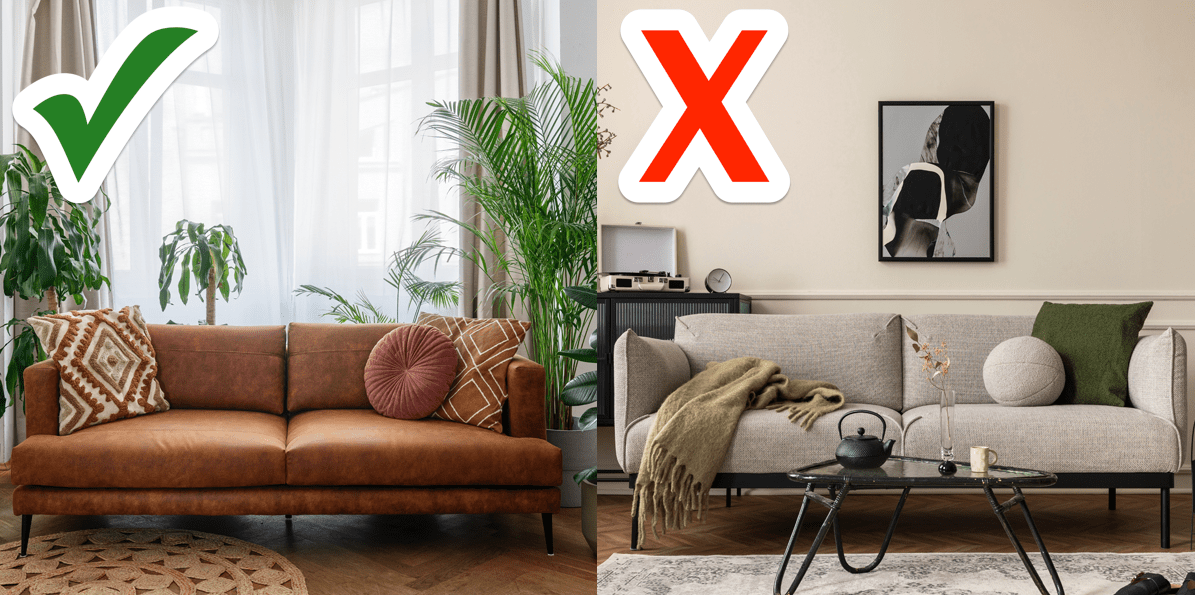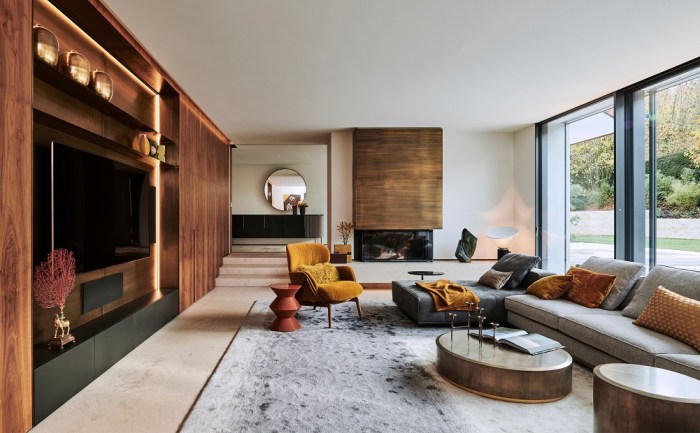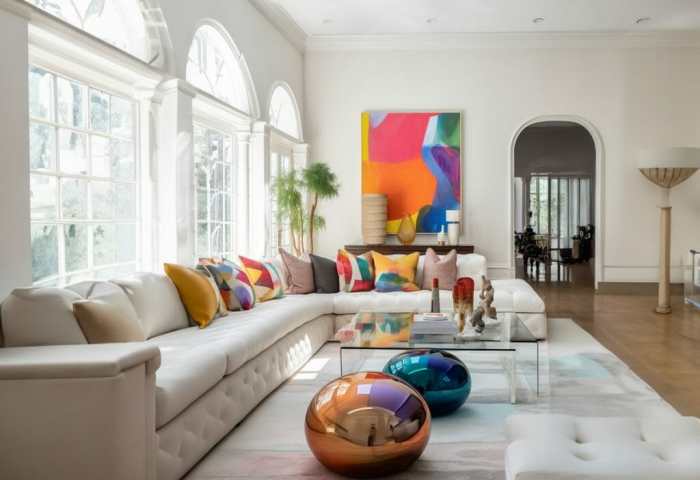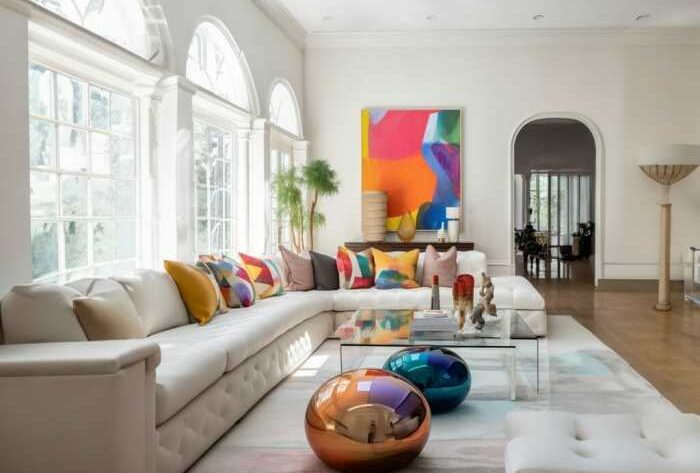2024 house interior design is poised for a captivating transformation, driven by a blend of technological advancements, evolving lifestyles, and a growing desire for sustainable and personalized living spaces. This year promises a fascinating fusion of trends, from the integration of smart home technology and the embrace of biophilic design to the enduring influence of minimalism and the captivating allure of cultural influences.
As we delve into the realm of 2024 interior design, we’ll explore the key trends shaping the future of home aesthetics. From the resurgence of natural materials and the adoption of sustainable practices to the rise of open-plan living and the power of color psychology, this year’s design landscape offers a rich tapestry of possibilities for creating functional and aesthetically pleasing living spaces.
Emerging Trends in 2024 House Interior Design

The world of interior design is constantly evolving, reflecting shifts in our lifestyles, values, and technological advancements. 2024 promises a fresh wave of trends that will redefine how we live and interact with our homes. These trends are driven by a desire for comfort, functionality, and sustainability, while embracing the latest technological innovations and design philosophies.
Biophilic Design
Biophilic design aims to integrate nature into our living spaces, creating a harmonious connection between the built environment and the natural world. This trend is driven by a growing awareness of the positive impact of nature on our well-being.
- Natural Materials:Biophilic design emphasizes the use of natural materials like wood, stone, bamboo, and textiles made from organic fibers. These materials bring warmth, texture, and a sense of authenticity to the interior.
- Indoor Greenery:Incorporating indoor plants, vertical gardens, and living walls is a key element of biophilic design. Plants purify the air, add visual interest, and contribute to a calming atmosphere.
- Natural Light:Maximizing natural light through large windows, skylights, and lightwells is crucial. Natural light improves mood, boosts productivity, and connects us to the outdoors.
- Water Features:Water fountains, aquariums, or even a small water feature can add a soothing and relaxing element to a space. The gentle sound of water is known to reduce stress and create a tranquil ambiance.
Sustainable Design Principles in 2024 Interiors
In the evolving landscape of interior design, sustainability is no longer a trend but a fundamental principle. As we become increasingly aware of our environmental impact, homeowners are seeking ways to create beautiful and functional spaces that are also eco-conscious.
This shift towards sustainable design is driven by a desire to minimize our footprint and create a healthier and more responsible living environment.
Eco-Friendly Materials
Sustainable design prioritizes the use of materials that are sourced responsibly and have minimal environmental impact.
- Recycled and Upcycled Materials:Incorporating recycled materials like reclaimed wood, salvaged tiles, and repurposed furniture adds character and reduces waste. Upcycling old furniture or transforming discarded objects into decorative pieces promotes creativity and sustainability.
- Natural Materials:Natural materials like bamboo, cork, and wool are renewable resources that are durable, aesthetically pleasing, and contribute to a healthier indoor environment. These materials often have a lower carbon footprint compared to synthetic alternatives.
- Sustainable Timber:Opting for sustainably harvested timber certified by organizations like the Forest Stewardship Council (FSC) ensures that forests are managed responsibly and that wood is sourced from ethical and environmentally sound practices.
Energy-Efficient Appliances
Energy-efficient appliances play a crucial role in reducing a home’s environmental impact.
- LED Lighting:LED lights consume significantly less energy than traditional incandescent bulbs, leading to lower energy bills and a reduced carbon footprint.
- Energy-Star Rated Appliances:Appliances with the Energy Star label meet specific energy efficiency standards, resulting in reduced energy consumption and lower operating costs.
- Smart Thermostats:Smart thermostats can learn your heating and cooling preferences and automatically adjust temperatures to optimize energy efficiency.
Sustainable Practices
Beyond materials and appliances, sustainable practices can transform a home into an eco-friendly haven.
- Water Conservation:Installing low-flow showerheads, water-efficient toilets, and rain barrels can significantly reduce water consumption.
- Natural Ventilation:Utilizing natural ventilation through windows and skylights reduces reliance on air conditioning and promotes better indoor air quality.
- Green Cleaning Products:Opting for non-toxic and biodegradable cleaning products minimizes the use of harsh chemicals and reduces pollution.
Responsible Sourcing and Ethical Production
Responsible sourcing and ethical production are integral to sustainable design.
- Local Sourcing:Prioritizing locally sourced materials reduces transportation costs and emissions associated with long-distance shipping.
- Fair Trade Practices:Choosing furniture and decor made with fair trade practices ensures that workers are treated fairly and paid a living wage.
- Transparency and Traceability:Supporting brands that offer transparent information about their manufacturing processes and material sourcing promotes ethical production.
Smart Home Technology Integration
Smart home technology is no longer a futuristic concept but a reality that is rapidly transforming the way we live. In 2024, this integration is poised to become even more seamless, blending functionality with aesthetics to create truly intelligent living spaces.
The impact of smart home technology on interior design is multifaceted. From enhancing functionality to elevating aesthetics, these systems are revolutionizing how we interact with our homes. Smart lighting, climate control, and entertainment systems are now seamlessly integrated into the design, creating a harmonious blend of technology and design.
A Hypothetical Smart Home Scenario
Imagine a home where the lighting automatically adjusts to the time of day and the occupants’ preferences. As you wake up, soft, warm light gradually illuminates the bedroom, mimicking the natural sunrise. As you move through the house, the lights follow you, automatically switching on and off as you enter and leave rooms.
The climate control system is equally intelligent. The thermostat learns your preferred temperature settings and adjusts the temperature accordingly. On a hot summer day, the system might automatically lower the blinds to block out the sun and activate the air conditioning.
During the winter, the system could automatically raise the temperature in the living room when you are home.
The entertainment system is also seamlessly integrated. With a simple voice command, you can turn on the TV, adjust the volume, or switch to a different channel. You can also control your music system from your smartphone, playing your favorite tunes in any room of the house.
Benefits and Challenges of Smart Home Technology Integration
Integrating smart home technology into residential spaces offers numerous benefits, including:
- Enhanced Comfort and Convenience:Smart homes automate tasks, making life easier and more comfortable. For example, you can control your lighting, temperature, and entertainment system from anywhere in the world with your smartphone.
- Increased Energy Efficiency:Smart homes can optimize energy consumption by adjusting lighting, heating, and cooling based on your needs and preferences. This can lead to significant savings on your energy bills.
- Improved Security:Smart home systems can enhance security with features like motion detectors, smart locks, and security cameras that can alert you to any suspicious activity.
- Personalized Experiences:Smart homes can be customized to meet your specific needs and preferences, creating a truly personalized living experience.
However, there are also some challenges associated with incorporating smart home technology:
- Initial Cost:Installing a smart home system can be expensive, especially if you are starting from scratch.
- Privacy Concerns:Smart home systems collect data about your habits and preferences, raising concerns about privacy.
- Technical Complexity:Setting up and maintaining a smart home system can be challenging for some people, especially those who are not tech-savvy.
- Security Risks:Smart home systems can be vulnerable to hacking, which could compromise your privacy and security.
The Rise of Biophilic Design
Biophilic design is a concept that emphasizes the connection between humans and nature. This approach is gaining momentum in 2024, as homeowners seek to create living spaces that promote well-being and enhance their quality of life.
Incorporating Natural Elements
The core principle of biophilic design is to bring the outdoors in. This can be achieved through various strategies, including:
- Plants:Incorporating plants into the home can significantly improve air quality and create a sense of tranquility. Large, leafy plants like monsteras or fiddle-leaf figs can act as natural air purifiers and add a touch of greenery to any space.
Smaller plants, such as succulents and herbs, can be placed on shelves, tables, or windowsills to add pops of color and life.
- Wood:Natural wood materials, such as oak, maple, and walnut, bring warmth and texture to a space. Wood flooring, furniture, and accents can create a sense of grounding and connection to nature. The use of reclaimed wood adds a unique character and sustainability aspect to the design.
- Natural Light:Maximizing natural light is crucial for promoting well-being and creating a sense of spaciousness. Large windows, skylights, and light wells can flood a home with natural light, reducing the need for artificial lighting and promoting a positive mood.
Benefits of Biophilic Design
Beyond aesthetics, biophilic design offers numerous psychological and physiological benefits:
- Stress Reduction:Studies have shown that exposure to nature can lower stress levels, reduce anxiety, and improve mood. Bringing natural elements into the home creates a calming and restorative environment, promoting relaxation and reducing feelings of overwhelm.
- Improved Focus and Concentration:Biophilic design can enhance cognitive function and improve focus. The presence of natural elements, such as plants and natural light, can stimulate the brain and create a more conducive environment for work or study. Research suggests that exposure to nature can improve attention span and reduce mental fatigue.
- Enhanced Well-being:Biophilic design promotes a sense of connection to nature, which can lead to increased feelings of well-being and happiness. The presence of natural elements can create a more positive and uplifting environment, reducing feelings of isolation and promoting a sense of peace and harmony.
The Impact of Cultural Influences

The globalized world we live in has a profound impact on interior design trends, as cultural influences are increasingly integrated into homes. This exchange of ideas and aesthetics leads to a vibrant tapestry of styles, blending traditional elements with modern interpretations.
Cultural Influences in 2024 Interior Design
The influence of different cultures is shaping the landscape of interior design in 2024, infusing homes with unique character and a sense of global sophistication. From the serene minimalism of Japanese design to the vibrant patterns of Moroccan interiors, these influences are transforming the way we think about our living spaces.
- Japanese Minimalism:This style emphasizes simplicity, functionality, and a connection with nature. It is characterized by clean lines, natural materials like wood and bamboo, and a focus on creating a sense of calm and tranquility.
- Scandinavian Simplicity:Known for its clean lines, light color palettes, and functional furniture, Scandinavian design prioritizes comfort and functionality.
The use of natural materials, such as wood and wool, creates a sense of warmth and inviting atmosphere.
- Moroccan Patterns:Moroccan design is rich in intricate patterns, vibrant colors, and luxurious textures. Intricate tilework, ornate lamps, and plush textiles create a sense of opulence and cultural richness.
A Hypothetical Interior Space Inspired by Moroccan Design
Imagine a living room inspired by the vibrant and intricate patterns of Moroccan design. The space features a plush rug with geometric patterns in shades of crimson, emerald, and sapphire. The walls are adorned with hand-painted tiles, each a unique work of art, showcasing traditional Moroccan motifs.
A low, ornate coffee table made of carved wood serves as the focal point, surrounded by plush cushions and throw pillows in rich fabrics. The room is illuminated by a handcrafted lantern, casting a warm glow over the space.
The overall effect is one of luxurious comfort, warmth, and cultural richness.
The Role of Color Psychology
Color psychology plays a crucial role in 2024 interior design, shaping the emotional experience of a space. Colors evoke specific feelings and influence mood, impacting the overall atmosphere and functionality of a room. Understanding the psychological effects of different colors allows designers to create spaces that are not only visually appealing but also promote well-being and productivity.
2024 house interior design trends are all about creating spaces that are both stylish and functional. A key element is maximizing vertical space, leading to a resurgence in popularity for 2 storey house design interior concepts. This allows for more room to breathe and create distinct areas within the home, reflecting the modern desire for versatility and individuality in home design.
The Emotional Impact of Colors
Color psychology is based on the idea that different colors have different psychological effects on people. These effects are often rooted in cultural associations and personal experiences, but there are some general principles that apply to most individuals. For example, warm colors like red, orange, and yellow are associated with energy, excitement, and stimulation.
2024 house interior design trends are all about embracing a sense of calm and functionality. Open floor plans, minimalist aesthetics, and natural materials are key, but you can still personalize your space. For a smaller footprint, consider exploring ideas for 1100 sq ft house interior design , which often focuses on maximizing space and incorporating clever storage solutions.
No matter your home’s size, 2024 is all about creating a space that feels both stylish and serene.
They can be used to create a sense of warmth and vibrancy in a space, but they can also be overwhelming in large doses. Cool colors like blue, green, and purple are associated with calmness, peace, and relaxation. They are often used to create a sense of serenity and tranquility, but they can also be perceived as cold or sterile.
Color Palette for a Home Office
Consider a home office space designed to promote focus and productivity. A color palette incorporating cool blues and greens can create a calming atmosphere conducive to concentration. * Blue:A light blue shade on the walls can create a sense of spaciousness and clarity, promoting focus and reducing stress.
Green
Green accents, such as a houseplant or artwork, can introduce a natural element, promoting relaxation and a sense of connection to nature.
White
White furniture and accents can enhance the sense of spaciousness and brightness, creating a clean and organized environment.
Color Harmony and Contrast
Color harmony refers to the pleasing combination of colors that work well together. A harmonious color palette can create a sense of balance and unity in a space, while contrasting colors can add visual interest and excitement. * Analogous Colors:Analogous colors are located next to each other on the color wheel, such as blue, blue-green, and green.
They create a sense of harmony and continuity.
Complementary Colors
Complementary colors are located opposite each other on the color wheel, such as red and green. They create a strong visual contrast and can be used to create a sense of energy and excitement.
Triadic Colors
Triadic colors are evenly spaced on the color wheel, such as red, yellow, and blue. They create a balanced and visually stimulating effect.By carefully considering the psychological effects of color, designers can create spaces that are not only beautiful but also promote the desired emotional response.
The Importance of Lighting

In 2024, lighting design is no longer just about illuminating a space; it’s about crafting an atmosphere, enhancing functionality, and elevating the overall aesthetic. Lighting has the power to transform a house into a home, setting the mood, highlighting architectural features, and impacting our well-being.
Lighting plays a crucial role in shaping the ambiance of a room. It can create a sense of warmth and intimacy, or a cool and modern vibe, depending on the type of lighting used. The right lighting can make a space feel more spacious, cozy, or even dramatic.
2024 house interior design trends are all about embracing individuality and creating spaces that reflect our unique personalities. From bold colors to statement furniture, there’s a lot of freedom to experiment. For those seeking a touch of vintage charm, consider incorporating elements of 1920s house interior design , with its geometric patterns and luxurious materials.
This blend of modern and retro can create a truly unique and timeless aesthetic for your 2024 home.
For example, using warm-toned light in a dining room can create a more inviting and intimate atmosphere, while cool-toned light in a home office can promote focus and productivity.
Lighting Plan for a Living Room
A well-designed lighting plan for a living room typically incorporates three types of lighting: ambient, task, and accent.
- Ambient Lighting: Provides overall illumination, setting the general mood of the room. This could be achieved through a combination of overhead fixtures, such as a chandelier or recessed lighting, and floor lamps.
- Task Lighting: Provides focused light for specific activities, like reading, working, or playing games. This could be accomplished with desk lamps, reading lamps, or under-cabinet lighting.
- Accent Lighting: Used to highlight specific features or objects, adding depth and interest to the space. This could involve using track lighting to showcase artwork, sconces to illuminate a bookshelf, or spotlights to highlight architectural details.
The Role of Natural Light
Natural light is essential for a healthy and visually appealing interior space. It brings in warmth, improves mood, and can reduce the need for artificial light during the day. Maximizing natural light through large windows, skylights, and light wells can significantly enhance the overall atmosphere and energy of a home.
The Role of Artificial Light, 2024 house interior design
Artificial light plays a crucial role in complementing natural light and providing illumination when needed. With advancements in lighting technology, there are numerous options available, including LED bulbs, smart lighting systems, and dimmers, allowing for greater control over the ambiance and functionality of a space.
Lighting Technology
Lighting technology is constantly evolving, offering innovative solutions for home interior design.
- Smart Lighting: Smart lighting systems allow you to control your lights remotely, adjust brightness and color temperature, and even automate lighting schedules. This technology provides convenience, energy efficiency, and enhanced control over the ambiance of your home.
- LED Lighting: LED bulbs are energy-efficient, long-lasting, and offer a wide range of color temperatures, allowing you to customize the ambiance of your space.
- Dimmers: Dimmers allow you to adjust the brightness of your lights, creating different moods and atmospheres for various activities.
Last Word: 2024 House Interior Design
In conclusion, 2024 house interior design is a dynamic and exciting field, characterized by a convergence of innovative trends and a renewed focus on functionality, sustainability, and personalization. As technology continues to advance and design philosophies evolve, the future of home interiors promises a harmonious blend of comfort, style, and well-being, reflecting the unique preferences and aspirations of individuals and families alike.
Detailed FAQs
What are some popular color palettes for 2024 house interior design?
Popular color palettes for 2024 include earthy tones like terracotta, sage green, and muted blues, along with warm neutrals like beige and cream. These colors create a sense of calm and connection to nature.
How can I incorporate biophilic design into my home?
You can incorporate biophilic design by bringing in natural elements like plants, wood, and natural light. Consider adding a living wall, incorporating wooden furniture, and maximizing natural light through large windows.
What are the benefits of open-plan living?
Open-plan living offers benefits like increased space utilization, a sense of openness and flow, and the ability to create multifunctional areas. However, it’s important to consider noise control and privacy when designing an open-plan layout.




